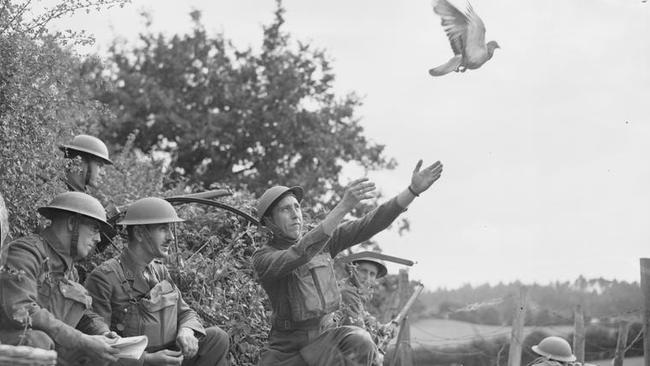Secret Pigeon Service: Operation Columba and Resistance in WWII
Risking injury and death, sometimes bringing home messages from the Germans, carrier pigeons helped Britain win WWII.

There were some Allied agents during World War II at considerably greater risk of being devoured than of being interrogated by the Gestapo: spy pigeons.
Some years ago, BBC journalist Gordon Corera followed a bizarre story about a dead pigeon found stuck up a chimney in Surrey. Attached to its leg “was a message which had stumped GCHQ’s top code-breakers”.
The incident led him to unearth the extraordinary, colourful and moving story of Operation Columba: British intelligence’s use of homing pigeons during the war to bring back from occupied Europe otherwise unobtainable and sometimes crucial information.
The pigeons were dropped over the Continent at night, sometimes from as low as 180m, in canisters with tiny parachutes attached. This was risky enough for the crew, let alone the poor pigeon. It was hoped, once they had landed in some field in northern France or Belgium, that a farmer would find the bird and follow the instructions in the canister. Although, as Corera notes, with rationing and food shortages, there was always a chance that digestion would prove the better part of valour on finding free fresh meat sitting in a tin.
However, lots of French and Belgian yeomen did leap at the chance to fight back against the Nazi occupation, at the risk of being charged with collaboration and facing imprisonment or execution. Inside the canister, along with the pigeon, was a small sack of feed — “an eggcupful of corn a day”, said the instructions — plus a pencil, two sheets of fine rice paper, a Resistance newspaper and a questionnaire.
We may imagine that by this time information was mainly communicated via radio. In fact, at the start of the 1940s radios were still in their infancy, and pigeons proved crucial. They could also cover the 320km back to Britain in an astonishing four hours, bringing with them a wealth of information: detailed maps of enemy troop deployment, gun emplacements, ammunition dumps and, later in the war, launch sites for the dreaded V1 and V2 rockets.
And sometimes the pigeons would gallantly fly home bearing only an obscene message from a mischievous German soldier.
The human players here are an eccentric cast of pigeon-fanciers, boffins and the dotty Viscount Tredegar, a promiscuous homosexual, compulsive gossip, keen occultist and great friend of the satanist Aleister Crowley. An ideal recruit for British intelligence. He was fired only after he blabbed about Operation Columba to some Girl Guides.
Across the Channel, the most valued informant signed himself Leopold Vindictive. He turned out to be a Catholic priest, Joseph Raskin, who had been a missionary in Mongolia as well as a stretcher-bearer in World War I. The intelligence he sent back was detailed and valuable. He was eventually arrested by the Gestapo and guillotined.
The book also pays tribute to the birds. They came from pigeon fanciers across the country. Obviously, the birds weren’t brave in the human sense. They had no idea what was going on, and were doing only what homing pigeons do: flying single-mindedly back home from wherever they were released, messages in tiny canisters attached to their legs, heading to the loft where they were born.
This burning desire to come home at all costs, though, is touching. Factor in the gunfire, shelling and flak, and pigeons sometimes fluttering back injured, and it is hard not to find it all rather stirring stuff.
The Americans were so touched by the return of some of their battered pigeons that they awarded them unofficial Purple Hearts. And Corera tugs at our hearts with a story from World War I about a British pigeon donated to the Americans on the Western Front and christened Cher Ami.
She flew back through enemy fire, was shot down, yet rose and flew on despite having been hit in the breast, blinded in one eye and with one leg almost hanging off. Her return saved the lives of a battalion surrounded by German troops. She subsequently had a wooden leg especially made for her by grateful soldiers, and now stands proud and stuffed in the Smithsonian Institution.
Between 1941 and 1944, a total of 16,554 pigeons were dropped, in an arc from Copenhagen to Bordeaux by British intelligence operatives. Casualties were high: from injuries during the drop, not being found at all, or being killed by “Nazi hawks”, peregrine falcons, on the way home. There were even what you might term “quisling falcons”, British birds who killed and ate the invaluable pigeons as they flew back over the cliffs of England.
As for the pigeon down the chimney in Surrey, it’s a romantic coda to this thrilling tale to learn that its coded message has to this day never been cracked.
Christopher Hart is a journalist and writer.
Secret Pigeon Service: Operation Columba, Resistance and the Struggle to Liberate Occupied Europe
By Gordon Corera
HarperCollins, 336pp, $32.95


